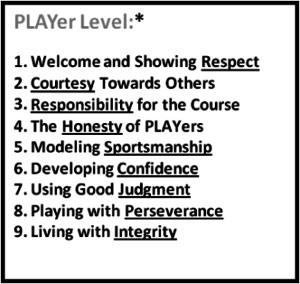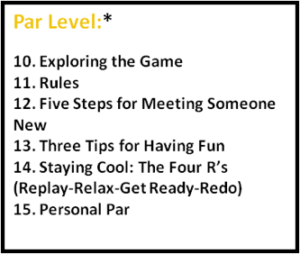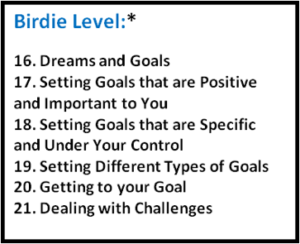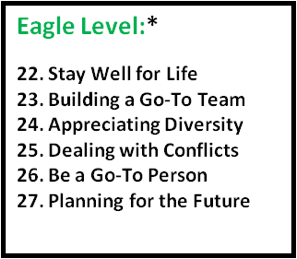 Hi, and happy new year to the parents and participants of The First Tee of Howard County! As I start to write this, it’s barely 16 degrees outside, so there is no golf going on today, but as always, we are thinking about your participants, and the role that keeping them in the program plays in making them better individuals and better golfers: “Good Golfers, Better People!”
Hi, and happy new year to the parents and participants of The First Tee of Howard County! As I start to write this, it’s barely 16 degrees outside, so there is no golf going on today, but as always, we are thinking about your participants, and the role that keeping them in the program plays in making them better individuals and better golfers: “Good Golfers, Better People!”
I have spoken with several parents over the past year as I have been filling in as Program Director, and find that I answer many similar questions about participants’ rate of advancement through the program. I have dealt with this in past articles in this space by spelling out the three main requirements for progression: proper age for the next level, successful completion (80 percent scores) on the academic tests of Golf and Life Skills knowledge, and successful completion of the golf skill and playing requirements at succeeding levels, all of which are required to move forward. Those are the objective markers we look at for progression in The First Tee, but they are by no means the only measures of progress or success in the program.
YOUTH DEVELOPMENT TAKES TIME
As I have explained to many parents previously, we are first and foremost a Youth Development Organization. Our success is in molding youth into responsible, empathetic individuals using golf as the foundation for that journey.
 The character-building part of The First Tee process is the hardest to measure at a moment in time; takes the longest time to achieve results; and is definitely not measurable based on their scores on our Life Skills and Golf Knowledge tests. It is not until we see those Nine Core Values and the dozen or so Life Skills that we teach demonstrated by your participants that we can be sure that they have actually absorbed them. Coaches are asked to evaluate each participant on each of the Core values and Life Skills taught in every class at every level. This process takes time— not days or months, but years.
DEVELOPING GOLF SKILLS IS HARD, REPETETIVE WORK
Some parents (and participants) become frustrated at what they perceive as the slow pace of their advancement and in some cases, their desire to do more and go further on the golf side of the program. As we tell parents at their initial orientation meeting, golf is properly taught from the hole backward, in a crawl, walk, and run approach. To be good golfers, we must be good putters (average golfers have the putter in their hands for as many as 60 percent of the strokes they will make during a round of golf).
The character-building part of The First Tee process is the hardest to measure at a moment in time; takes the longest time to achieve results; and is definitely not measurable based on their scores on our Life Skills and Golf Knowledge tests. It is not until we see those Nine Core Values and the dozen or so Life Skills that we teach demonstrated by your participants that we can be sure that they have actually absorbed them. Coaches are asked to evaluate each participant on each of the Core values and Life Skills taught in every class at every level. This process takes time— not days or months, but years.
DEVELOPING GOLF SKILLS IS HARD, REPETETIVE WORK
Some parents (and participants) become frustrated at what they perceive as the slow pace of their advancement and in some cases, their desire to do more and go further on the golf side of the program. As we tell parents at their initial orientation meeting, golf is properly taught from the hole backward, in a crawl, walk, and run approach. To be good golfers, we must be good putters (average golfers have the putter in their hands for as many as 60 percent of the strokes they will make during a round of golf).  A “routine” round of golf, in which a player hits the green on his or her first, second or third shot (i.e., “in regulation”) depending on whether he or she is on a Par 3, Par 4 or Par 5 respectively, will then allow the player up to two putts per hole to shoot Par. That would represent 36 strokes or fully 50 percent of the strokes hit in a Par 72 round. Given that most of us are not Par golfers, that number of putts may soar even higher, highlighting the importance of becoming skillful with the putter. The quickest way, bar none, for a golfer to lower his or her scores, is to learn to putt better. The practice to do this is arduous, takes lots of time and loads of experience and repetitions.
THE LIFE SKILLS WE TEACH ARE UNIQUE TO THE FIRST TEE
So, you can see that looking at putting alone, which takes place on a relatively smooth, well-manicured surface under relatively controlled conditions, the process can take time. By extension, then, in our crawl-walk-run approach, the second most important stroke we teach, and the second in succession, is the chip. A chip is a shot hit from near the green, with a slightly lofted club, designed to fly a short distance, and convert on the first bounce to a putt-like rolling action, in an attempt to leave the ball close enough to the hole to sink the first putt to save Par. Many of the factors in chipping are similar to putting, the stroke is similar, but the variables are more influential given that the chip is initiated not on the smooth, finely manicured green, but from the rough or fairway surrounding or approaching the green, which can influence the factors involved in the stroke’s reliability. At the same time as we are working on basic skills with your participants (putting, chipping and pitching), we are repetitively training them in the Nine Core Values and Life Skills. From the perspective of these important components of The First Tee Journey (which, by the way are not taught in any other Junior Golf program), it is not enough for our participants to be able to name and define the Nine Core Values and recall the Life Skills taught at the PLAYer, Par and Birdie Levels of The First Tee (see the dialog boxes in this article), but they must put them into practice both in a classroom context, and away from The First Tee, and be able to describe how they did that. It is not unusual to see a participant who comes to the next level of the program or even two levels beyond, who cannot do some of the simple things that they were previously taught, have answered test questions about, and have appeared to have mastered previously.
Not all of our participants are capable of moving at the same pace, on either side of the ledger. Some of our participants take to golf and show promise more quickly than others. To maintain their interest, even as they may be struggling with the Life Skills and waiting to meet the age bar to move to the next level, we have our Tuesday evening golf enrichment classes, conducted by a local Professional Golfer with broad experience in coaching elite area High School and College players. Participants for these classes, which come at no charge and in addition to their current classes, are selected by nomination for a limited number of participants (8) per session (two four week sessions of two hours each for four students per session). In these classes (a one-time only opportunity for each participant chosen) the participants are given golf-specific training, guidance and exercises to accomplish in addition to their normal class homework.
A “routine” round of golf, in which a player hits the green on his or her first, second or third shot (i.e., “in regulation”) depending on whether he or she is on a Par 3, Par 4 or Par 5 respectively, will then allow the player up to two putts per hole to shoot Par. That would represent 36 strokes or fully 50 percent of the strokes hit in a Par 72 round. Given that most of us are not Par golfers, that number of putts may soar even higher, highlighting the importance of becoming skillful with the putter. The quickest way, bar none, for a golfer to lower his or her scores, is to learn to putt better. The practice to do this is arduous, takes lots of time and loads of experience and repetitions.
THE LIFE SKILLS WE TEACH ARE UNIQUE TO THE FIRST TEE
So, you can see that looking at putting alone, which takes place on a relatively smooth, well-manicured surface under relatively controlled conditions, the process can take time. By extension, then, in our crawl-walk-run approach, the second most important stroke we teach, and the second in succession, is the chip. A chip is a shot hit from near the green, with a slightly lofted club, designed to fly a short distance, and convert on the first bounce to a putt-like rolling action, in an attempt to leave the ball close enough to the hole to sink the first putt to save Par. Many of the factors in chipping are similar to putting, the stroke is similar, but the variables are more influential given that the chip is initiated not on the smooth, finely manicured green, but from the rough or fairway surrounding or approaching the green, which can influence the factors involved in the stroke’s reliability. At the same time as we are working on basic skills with your participants (putting, chipping and pitching), we are repetitively training them in the Nine Core Values and Life Skills. From the perspective of these important components of The First Tee Journey (which, by the way are not taught in any other Junior Golf program), it is not enough for our participants to be able to name and define the Nine Core Values and recall the Life Skills taught at the PLAYer, Par and Birdie Levels of The First Tee (see the dialog boxes in this article), but they must put them into practice both in a classroom context, and away from The First Tee, and be able to describe how they did that. It is not unusual to see a participant who comes to the next level of the program or even two levels beyond, who cannot do some of the simple things that they were previously taught, have answered test questions about, and have appeared to have mastered previously.
Not all of our participants are capable of moving at the same pace, on either side of the ledger. Some of our participants take to golf and show promise more quickly than others. To maintain their interest, even as they may be struggling with the Life Skills and waiting to meet the age bar to move to the next level, we have our Tuesday evening golf enrichment classes, conducted by a local Professional Golfer with broad experience in coaching elite area High School and College players. Participants for these classes, which come at no charge and in addition to their current classes, are selected by nomination for a limited number of participants (8) per session (two four week sessions of two hours each for four students per session). In these classes (a one-time only opportunity for each participant chosen) the participants are given golf-specific training, guidance and exercises to accomplish in addition to their normal class homework.
 In addition, for those participants who wish to take their learning to the course in friendly competition against The First Tee participants from Howard County and other surrounding First Tee Chapters, we have the Metro Tour, which while age- and First Tee level-bounded (age 12 and in Birdie for many events), provides an opportunity for participants to try their skills among peers on the golf course. There are competitions for girls only, Par level participants (9 and older in Par or higher level), Birdie, Eagle and ACE levels as well. These nine-hole (and a few 18-hole) opportunities allow our participants to play at very fine courses, often private ones, in the Baltimore-Washington area for a nominal cost, where they play nine or eighteen holes of golf and receive lunch in addition. About the only requirement is that they obtain a $20 annual Metro Tour Membership (online through our website), pay $10 per event, and, importantly, be able to walk 9 or 18 holes carrying their own clubs. And, starting this year, we will also have limited transportation available using The First Tee Howard County Van, between Fairway Hills and away locations, to support those participants whose parents may not be available to drive them to and from the competition courses.
Finally, we hope this year to also establish a league-type competition opportunity within The First Tee of Howard County, to enable participants who are old enough to be on course without adult supervision (generally 12 years and older) to play with their friends and fellow participants on a challenge basis. Details for this are yet to be worked out.
THE PAYOFF IN THE PROGRAM COMES LATER—BUT ONLY TO THOSE WHO PERSEVERE
But, now back to my original theme, that of retention. Why is it essential for your participants to stay with The First Tee into and through their teen years? It is because at age 14, or high school age, the true benefits of The First Tee become attainable. This is the point in their lives at which your participants are capable of unaccompanied travel by air to locations across the country to take part in The First Tee National Opportunities which contribute to their life experiences, skill portfolios, STEM (science, technology, engineering and math) knowledge, and the like. These opportunities, available only through The First Tee, require competitive selection (in chapter and across The First Tee), and also require that applicants have been in The First Tee a minimum length of time (usually three years at the time of application or particular program start date); be continuously enrolled (at least one session per year); be involved in mentoring activities in The First Tee or other local organizations; and be certified to a certain First Tee Level (usually at least Par or Birdie). Oh, and by the way, a number of these opportunities include competition for college scholarships.
In addition, for those participants who wish to take their learning to the course in friendly competition against The First Tee participants from Howard County and other surrounding First Tee Chapters, we have the Metro Tour, which while age- and First Tee level-bounded (age 12 and in Birdie for many events), provides an opportunity for participants to try their skills among peers on the golf course. There are competitions for girls only, Par level participants (9 and older in Par or higher level), Birdie, Eagle and ACE levels as well. These nine-hole (and a few 18-hole) opportunities allow our participants to play at very fine courses, often private ones, in the Baltimore-Washington area for a nominal cost, where they play nine or eighteen holes of golf and receive lunch in addition. About the only requirement is that they obtain a $20 annual Metro Tour Membership (online through our website), pay $10 per event, and, importantly, be able to walk 9 or 18 holes carrying their own clubs. And, starting this year, we will also have limited transportation available using The First Tee Howard County Van, between Fairway Hills and away locations, to support those participants whose parents may not be available to drive them to and from the competition courses.
Finally, we hope this year to also establish a league-type competition opportunity within The First Tee of Howard County, to enable participants who are old enough to be on course without adult supervision (generally 12 years and older) to play with their friends and fellow participants on a challenge basis. Details for this are yet to be worked out.
THE PAYOFF IN THE PROGRAM COMES LATER—BUT ONLY TO THOSE WHO PERSEVERE
But, now back to my original theme, that of retention. Why is it essential for your participants to stay with The First Tee into and through their teen years? It is because at age 14, or high school age, the true benefits of The First Tee become attainable. This is the point in their lives at which your participants are capable of unaccompanied travel by air to locations across the country to take part in The First Tee National Opportunities which contribute to their life experiences, skill portfolios, STEM (science, technology, engineering and math) knowledge, and the like. These opportunities, available only through The First Tee, require competitive selection (in chapter and across The First Tee), and also require that applicants have been in The First Tee a minimum length of time (usually three years at the time of application or particular program start date); be continuously enrolled (at least one session per year); be involved in mentoring activities in The First Tee or other local organizations; and be certified to a certain First Tee Level (usually at least Par or Birdie). Oh, and by the way, a number of these opportunities include competition for college scholarships. These programs are described in the back of the 2017 Parents Guide (pp 15-forward), in the section called “National Opportunities.” Most parents have not read (although we distribute them to incoming parents and have them available for all parents during each session) the Parents’ Guide to The First Tee. I encourage you to read the 2017 guide.
This guide provides detailed information on what intentions focus our attention, and most importantly, what opportunities are available to those participants who stay with the program into their teens. This is where the real goodness in The First Tee is. These opportunities, numbering more than a dozen in any given year, are only available to participants who have reached high school age. The reasoning here is that at 14 years of age, minors are permitted to travel via air independently, and many of these opportunities require air travel. They range from seminars of three days to opportunities offering a full week away among First Tee peers and coaches, where golf, character, and leadership development related activities are offered in a supportive environment. These opportunities are competitive, based on the grades, extracurricular activities, service hours to First Tee and other organizations, and other accomplishments of First Tee participants, rather than solely on their golf ability. For most of them beginning in 2018, there is a required USGA handicap that must be met, but the bulk of those have a relatively low bar to entry (Handicap 18 equates to scores in the high 80’s to low 90’s for 18 holes).
These experiences, for those fortunate enough to be selected, enable them to work on independence, and to build networks of friends who enjoy a common interest well beyond their local First Tee Chapter.
On the other hand, participants who have become bored, or fallen out of step with The First Tee beforehand, or who have chosen to opt for other activities in place of The First Tee, will never be able to participate in these opportunities, to reap the rewards of having “stuck it out” (PERSEVERANCE – Core Value).
SURVIVING THE CRITICAL PERIOD IS WORTH THE EFFORT
Our demographics indicate that if participants stay with us and achieve the progression goals required through the Birdie level (basically when participants arrive at the 11-13 age group), they tend to stay through Eagle and some may progress to ACE, the highest level of The First Tee. The competition for their time provided by scholastic and other team sports, music and other club or team pursuits, along with limited discretionary time is part of the reason that participants leave the program. In some cases, they believe they have “learned enough” or the pace is “too slow” to keep their interest. Yet, despite the numbers of hours and repetitions it takes to learn the golf fundamentals we are teaching, not to mention the values we are trying to inculcate, the participants who spend the least time practicing those skills tend to be the ones who leave the program. Naturally, we would like to see all of our participants remain with the program through completion (at least through the Eagle level). But we know today, that is wishful thinking. What we would hope is that participants and parents who have invested 4-6 years in The First Tee process would not simply drift away without opening a dialogue with us about how we might make their particular experience better and more meaningful in hope of retaining them in the program. Our door is always open for those discussions.
So, if you or your participants are becoming disheartened by the pace or length of our process, don’t hesitate to reach out to us. We are happy to talk by phone (410-730-1114), in person at The First Tee Office at Fairway Hills, or to take your questions via email at [email protected], or to my email directly at [email protected]
We wish you and your families a healthy and happy 2018, and look forward to continuing to provide the best service possible to your participants. I would love to say about your participants, as I have in numerous recommendation letters for participants in their late teens going on to bigger and better things, that I have known and coached them from age 8 or 9 to 17, and can therefore vouch enthusiastically for their qualifications and character. We want all of your participants to grow up to be “Good Golfers, Better People!”
*Core Lesson Titles from The First Tee Yardage Books, © 2015 The First Tee. All rights reserved. Used with permission.
These programs are described in the back of the 2017 Parents Guide (pp 15-forward), in the section called “National Opportunities.” Most parents have not read (although we distribute them to incoming parents and have them available for all parents during each session) the Parents’ Guide to The First Tee. I encourage you to read the 2017 guide.
This guide provides detailed information on what intentions focus our attention, and most importantly, what opportunities are available to those participants who stay with the program into their teens. This is where the real goodness in The First Tee is. These opportunities, numbering more than a dozen in any given year, are only available to participants who have reached high school age. The reasoning here is that at 14 years of age, minors are permitted to travel via air independently, and many of these opportunities require air travel. They range from seminars of three days to opportunities offering a full week away among First Tee peers and coaches, where golf, character, and leadership development related activities are offered in a supportive environment. These opportunities are competitive, based on the grades, extracurricular activities, service hours to First Tee and other organizations, and other accomplishments of First Tee participants, rather than solely on their golf ability. For most of them beginning in 2018, there is a required USGA handicap that must be met, but the bulk of those have a relatively low bar to entry (Handicap 18 equates to scores in the high 80’s to low 90’s for 18 holes).
These experiences, for those fortunate enough to be selected, enable them to work on independence, and to build networks of friends who enjoy a common interest well beyond their local First Tee Chapter.
On the other hand, participants who have become bored, or fallen out of step with The First Tee beforehand, or who have chosen to opt for other activities in place of The First Tee, will never be able to participate in these opportunities, to reap the rewards of having “stuck it out” (PERSEVERANCE – Core Value).
SURVIVING THE CRITICAL PERIOD IS WORTH THE EFFORT
Our demographics indicate that if participants stay with us and achieve the progression goals required through the Birdie level (basically when participants arrive at the 11-13 age group), they tend to stay through Eagle and some may progress to ACE, the highest level of The First Tee. The competition for their time provided by scholastic and other team sports, music and other club or team pursuits, along with limited discretionary time is part of the reason that participants leave the program. In some cases, they believe they have “learned enough” or the pace is “too slow” to keep their interest. Yet, despite the numbers of hours and repetitions it takes to learn the golf fundamentals we are teaching, not to mention the values we are trying to inculcate, the participants who spend the least time practicing those skills tend to be the ones who leave the program. Naturally, we would like to see all of our participants remain with the program through completion (at least through the Eagle level). But we know today, that is wishful thinking. What we would hope is that participants and parents who have invested 4-6 years in The First Tee process would not simply drift away without opening a dialogue with us about how we might make their particular experience better and more meaningful in hope of retaining them in the program. Our door is always open for those discussions.
So, if you or your participants are becoming disheartened by the pace or length of our process, don’t hesitate to reach out to us. We are happy to talk by phone (410-730-1114), in person at The First Tee Office at Fairway Hills, or to take your questions via email at [email protected], or to my email directly at [email protected]
We wish you and your families a healthy and happy 2018, and look forward to continuing to provide the best service possible to your participants. I would love to say about your participants, as I have in numerous recommendation letters for participants in their late teens going on to bigger and better things, that I have known and coached them from age 8 or 9 to 17, and can therefore vouch enthusiastically for their qualifications and character. We want all of your participants to grow up to be “Good Golfers, Better People!”
*Core Lesson Titles from The First Tee Yardage Books, © 2015 The First Tee. All rights reserved. Used with permission.
